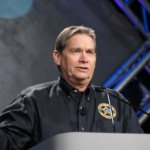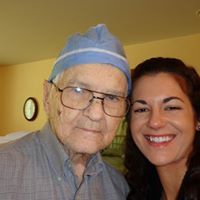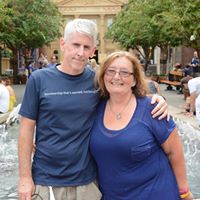James W Christy
age ~87
from Harwood, MD
- Also known as:
-
- James Walter Christy
- James A Christy
- Jw W Christy
- Charlene Christy
- Christy James
James Christy Phones & Addresses
- Harwood, MD
- 1720 Niona Pl, Tucson, AZ 85704
- Coronado, AZ
- Flagstaff, AZ
- Berwyn Heights, MD
License Records
James Christy
License #:
2705058407
Category:
Contractor
James Christy/Katri Christy
License #:
2705099694
Category:
Contractor
Lawyers & Attorneys

James Christy - Lawyer
view sourceISLN:
908389399
Admitted:
1970
University:
University of Illinois, B.A., 1967
Law School:
Loyola University, J.D., 1970

James Christy - Lawyer
view sourceISLN:
908389382
Admitted:
1973
University:
University of Cincinnati, B.B.A., 1969
Law School:
University of Cincinnati, J.D., 1972
Name / Title
Company / Classification
Phones & Addresses
Manager
Xtreme Property Management LLC
Branch Manager
Haworth, Inc
Mfg Wood Office Furniture Mfg Office Furniture-Nonwood
Mfg Wood Office Furniture Mfg Office Furniture-Nonwood
1875 Interstate St NW, Washington, DC 20006
(202)2938908
(202)2938908
Us Census
The Census United States Bureau of
4700 Silver Hl Rd, Washington, DC 20233
(301)7635768
(301)7635768
IBASH PROPERTIES LLC
ROLSTON GREY LLC
T. C. TRUCKING-01 LLC
JPC LC
EDWARD STARR ENTERPRISES LLC
Us Patents
-
Low-Temperature Blackbody Radiation Source
view source -
US Patent:62326147, May 15, 2001
-
Filed:Oct 13, 1998
-
Appl. No.:9/170543
-
Inventors:James W. Christy - Tucson AZ
James R. Rochester - Tucson AZ -
International Classification:G01J 500
-
US Classification:250504R
-
Abstract:A blackbody radiation source includes an insulated enclosure having a viewing aperture defining a line of sight through the wall of the enclosure. A heat sink, preferably a pool of liquid nitrogen, is located within the insulated enclosure. There is a viewing surface in thermal contact with the heat sink but having an unobstructed view through the viewing aperture. The viewing surface is inclined to the line of sight through the viewing aperture. A sensor is calibrated by placing the sensor in facing relation to the aperture and measuring an output black body signal of the sensor. The viewing surface may be radiatively heated concurrently with the measuring to produce a higher equivalent radiometric temperature.
Resumes

Director, Futures Exploration At Defense Cyber Crime Center
view sourceLocation:
Baltimore, Maryland Area
Industry:
Law Enforcement

James Christy
view sourceLocation:
United States

James Christy
view sourceLocation:
United States

Senior Wealth Advisor At Northwest Financial Group
view sourceLocation:
Washington D.C. Metro Area
Industry:
Financial Services
Isbn (Books And Publications)

Wikipedia References

James W . Christy
About:
Born:
1938
Work:
Position:
Astronomer
Skills & Activities:
Preference:
Mate

James W. Christy
Plaxo

Christy James
view sourceFacilitator / Community Development Consultant at...

James Christy
view sourcePhoenix, AZJIM CHRISTY STUDIO
Myspace
Classmates

James Christy
view sourceSchools:
St. Joseph's Prep School Philadelphia PA 1955-1959, Cecilian Academy Philadelphia PA 1955-1959
Community:
Bridget Gallagher, Kenneth Laplaunt, Regina Giovinazzo

James Christy Jr (Christy)
view sourceSchools:
Fillmore High School Fillmore IN 1956-1960
Community:
James Oursler, Steve Robinson

James Christy
view sourceSchools:
Allen Park High School Allen Park MI 1988-1992
Community:
Renee Cook

James Christy
view sourceSchools:
Wooster High School Reno NV 1973-1977
Community:
Linda Cheel, Yvette Lopez

James Christy
view sourceSchools:
Saint John the Baptist School Monaca PA 1969-1976
Community:
Joseph D'alessandris, James Lowery

James Christy
view sourceSchools:
Hempfield Elementary School Greenville PA 1981-1984, East Elementary School Greenville PA 1985-1987, Mercer County Vocational Technical School Mercer PA 1991-1994
Community:
Steve Smith, Richard Sweigard, William Sweigard, Tom Hodge

James Christy
view sourceSchools:
Lockney Junior High School Lockney TX 1978-1978
Community:
Darlene Lambert, Fran Lapp

James Christy
view sourceSchools:
Plainville High School Mariemont OH 1941-1945
Community:
Nancy Ross, Barbara Mueller
Youtube
News

NASA releases Pictures Showing a day on Pluto and Its Moon Charon
view source- Charon was discovered by United States Naval Observatory astronomer James Christy, using the 1.55-meter telescope at NOFS, and was formally announced to the world via the International Astronomical Union on July 7, 1978. Subsequent observations of Pluto determined that the bulge was due to a smaller
- Date: Nov 21, 2015
- Category: Sci/Tech
- Source: Google

US Spacecraft Sails by Pluto, Capping 9-year Journey
view source- Other celestial-minded VIPs included James Christy, discoverer of Pluto's big moon Charon, and Sylvia Kuiper des Tombe, daughter of Dutch-American Gerard Kuiper for whom the mysterious zone surrounding Pluto is named. Some Pluto Children born Jan. 19, 2006, the very day New Horizons departed Earth
- Date: Jul 15, 2015
- Source: Google

How our view of Pluto and its moons has transformed through the decades
view source- scientists used data collected by the Hubble Space Telescope and other observatories to learn more about Pluto and hunt for moons around the tiny planet. The small planet's largest moon Charon was discovered in 1978 by U.S. Naval Observatory astronomer James Christy peering through a telescope in Arizona.
- Date: Jul 09, 2015
- Category: Sci/Tech
- Source: Google

Climate Quitters: Sorry You Lose
view source- Spencer, it is fair to say, does not have a sparkling reputation among climate scientists, not least because he and UAH colleague James Christy previously maintained that their data showed no warming in Earth's atmosphere, a claim long embraced by deniers but one that Spencer and Christy now concede
- Date: Sep 15, 2011
- Source: Google
Flickr
Googleplus

James Christy
Work:
Pokémon - Manager
Education:
University of Notre Dame

James Christy
Education:
Lol
Tagline:
James is just this guy, you know?

James Christy
Relationship:
Single
About:
BE COOL AND SEXY DUDE
Tagline:
COOL
Bragging Rights:
RUNNING ACROSS SUCCESS

James Christy

James Christy

James Christy

James Christy

James Christy

James Christy
view source
James True Christy
view source
James Christy
view source
James Christy
view source
James Christy
view source
James Christy
view source
James Christy
view source
James J. Christy
view sourceGet Report for James W Christy from Harwood, MD, age ~87













